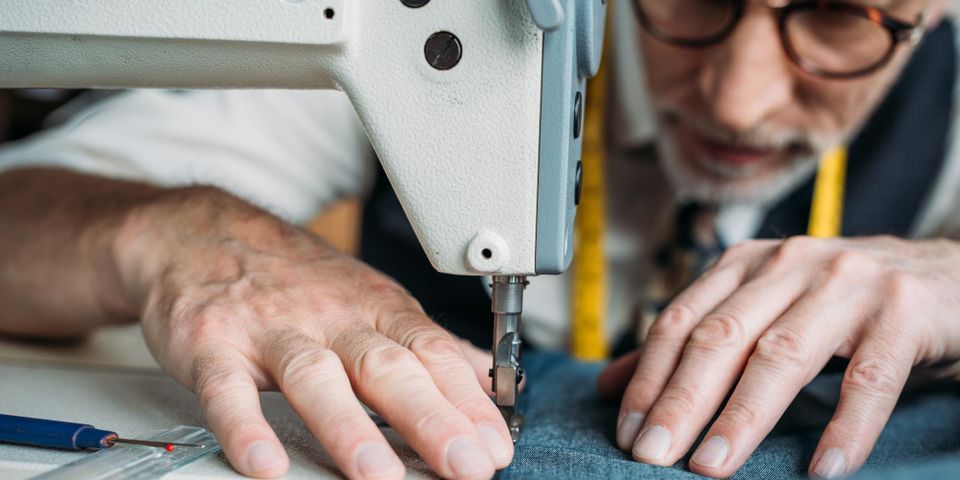How to Select the Right Sewing Machine Needle for Your Project

There are many aspects of sewing a garment that factor into the design process. Whether you prefer to work with spandex, denim, or leather, choosing the right sewing machine needle is essential for your project’s success. Here are the basics of how this tool is structured and how its unique properties can affect the sewing process.
How Stitching Works With a Sewing Machine
A Brief Anatomy of a Needle
Before embarking on your next sewing project, you first need to understand the parts of a sewing machine needle and how they work together:
- The shank is the top of the needle that attaches it securely to the machine.
- The shaft determines the needle size, as it is the main body that dictates the diameter of the needle hole.
- The long and short groove cradle the thread so it can smoothly form stitches.
- The scarf is an indentation to the back of the needle that allows the bobbin hook to loop thread more easily.
- The point is what actually pierces the material to form the stitch.
- The eye is the hole that thread passes through.
The various sections of a sewing machine needle differ in size based on the needs of the material.
How a Machine Creates the Stitch
Making a stitch on a sewing machine requires an interaction between the needle and the bobbin hook. Each one is comprised of two threads—the upper thread fed through the eye and the bobbin thread surfaced by the circular-spinning bobbin hook. The stitch begins when the needle penetrates the fabric and reaches its lowest point. The bobbin hook then slides by the scarf, catches the upper thread, and wraps it around the bobbin thread. As the point recedes and the bobbin hook spins around, the stitch tightens into place, and the process repeats.
Types of Needles
 Universal
Universal
For beginners, this needle is the safest choice for most fabrics. Its slightly rounded point and elongated scarf make for easy use. When working with more cumbersome material, like denim or spandex, you’ll likely need to go for needles catered to specific fabrics.
Ballpoint & Stretch Needles
Needles with rounded points stitch between fibers of fabric instead of piercing the material. This ability is necessary with looser knits that have relatively wide spacing in their weaving patterns and with spandex fabrics, which will unravel if the fibers are broken.
Microtex & Sharp
These needles’ acutely sharp points are best for sewing microfiber, silk, and synthetic leather. Their biggest asset is their exactness, which can be beneficial for precise edges and heirloom sewing.
Leather
With genuine leather, you need a point that can slightly cut through the material, similar to an arrowhead. This type of needle will likely not work on synthetic leather, as it can tear and ruin the fabric.
Denim (Jeans)
For ultra-heavyweight fabrics, you need a needle that will go through the material without pushing the fabric down into the needle plate hole. Jeans needles have a deeper scarf, sharp point, and modified shaft that go through the fabric and meet the bobbin hook effectively. If the machine skips stitches, use a larger needle, sew more slowly, and walk the material through using the hand crank.
Handicap or Self-Threading
For those with vision problems, handicap needles will have a slip-in threading slot at the eye, which makes for easier threading. This helpful assistant is typically a universal point, so it will work well on woven fabrics but may snag the occasional knit.
Topstitching
With an extra-acute point, extra-large eye, and large grooves for heavy thread, this needle allows for topstitching, otherwise known as the decorative and functional stitching you can see on the pockets of your jeans. Since the thread will be thicker than usual, try to use the smallest needle possible to keep the holes as small as possible.
Embroidery
Embroidery requires extreme precision to cater to the designs at hand. The needle must have a light point and larger eye to assure that the decorative thread doesn’t break during sewing. Particularly dense designs may need a larger diameter shaft or metallic needle to handle the thread.
Metallic (Metafil & Metallica)
Similar to the embroidery needle, this tool attempts to protect decorative threads, especially finicky metallic threads. They typically have a universal point with an oversized eye and a large groove to allow the fragile thread to avoid snagging.
Quilting (Stippling)
Since quilting uses multiple layers of fabric, it requires a point that can penetrate through these thick layers without breaking. A quilting needle has a tapered shaft to prevent damaging the various materials as it creates each stitch.
Hemstitch (Wing)
Hemstitching is decorative drawn threadwork that creates a pattern at the hem of tight knit fabrics like linen or batiste. This specialty needle has fins on the sides of the shank to create holes as you sew, which is useful when you need to return it to the same hole for this stitch.
Twin (Double) & Triple
Two-to-three points are attached to a single shaft with a crossbar, which can create two or three rows of stitching. Double and triple needles can come with universal, stretch, embroidery, denim, and metallic points, and they are used for topstitching, pin tucking, and decorative stitching.
Spring
As the name suggests, this needle has a wire spring above the point to prevent the fabric from riding up onto the shaft. It is used for free-motion stitching with dropped feed dogs, and it eliminates the need for a presser foot.
Choosing Needle Size
 Deciphering the correct needle size depends on the material you’re using. Different weighted fabrics have varied give to them, requiring a specifically sized needle to effectively pierce through the material without breaking.
Deciphering the correct needle size depends on the material you’re using. Different weighted fabrics have varied give to them, requiring a specifically sized needle to effectively pierce through the material without breaking.
There are two main sizing systems for needles. European ones have a sizing range of 60 to 120, referring to the diameter of the shaft just above the eye. American ones range from sizes 8 to 19, an arbitrary scale that does pair precisely with European sizes. For either, the larger the number equates to a larger diameter.
Typical needle sizes based on fabric weight are as follows:
- Size 60/8: lightweight fabrics like georgette or organdy
- Size 70/10 or 80/12: medium-weight material, such as jersey, spandex, linen, or calf leather
- Size 90/14 or 100/16: heavy-weight fabrics, including jeans, vinyl, upholstery, or canvas
- Size 110/18 or 120/19: heaviest material
Thread can also be a concern, as more delicate decorative threads will need a smooth path to the stitch through the front groove. If the fiber snags, it can create a messy stitch or cause the machine to not stitch at all. This is a sign that the needle and thread are not correctly matched. To assure that you have the right needle, lay the thread in the groove to confirm it fits and can easily glide through this space.
Upkeep of Needles
Ultimately, the life span of the needle relies on a keen knowledge of which types work best for the material you’re using. If you put thought into this step, a new one in your machine should last for up to 12 hours of sewing. Skipped stitches, shredded thread or material, and bent or broken needles are common signs that you have chosen incorrectly. With spandex, for example, a universal needle will tear apart the fabric because its point is too sharp. In contrast, using a ballpoint needle on leather will result in a broken needle due to the coarse material. Taking the time to consider the best option and testing potential choices will save you time and frustration on a project.
When you’re working with high-quality spandex, like the bolts of fabric you’ll find at Spandex House, Inc., you’ll need a ballpoint or stretch needle for the job. Whether you’d like to see samples or order the material for your next project, visit their website or give them a call today at  (212) 354-6711
(212) 354-6711
About the Business
Have a question? Ask the experts!
Send your question

